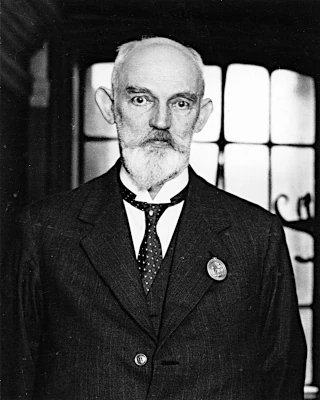
Willem de Sitter was born on May 6, 1872 in Sneek, Netherlands. His father, Lambertus de Sitter, was a judge at the Court of Appeal in Leeuwarden. After secondary education in Arnhem, he entered the University of Groningen in 1889 to study mathematics.
In 1897, he earned his doctorate under the supervision of Jacobus Cornelius Kapteyn (1851-1922) with a thesis on solutions of differential equations in astronomy. He then spent two years at the Cape Observatory in South Africa, where he specialized in the study of binary stars and stellar photometry.
In 1908, de Sitter was appointed professor of astronomy at Leiden University and director of Leiden Observatory, a position he held until his death. He thus succeeded Hendrik Lorentz (1853-1928), another giant of Dutch theoretical physics.
His main achievements at Leiden included:
De Sitter's most important contributions concern relativistic cosmology. In 1916-1917, he found two exact solutions to Einstein's equations for a universe empty of matter (except possibly a cosmological constant):
This solution describes an empty universe in exponential expansion, where the scale factor \( a(t) \) grows as \( e^{Ht} \), with \( H \) proportional to the square root of the cosmological constant \( \Lambda \). This solution shows that:
In collaboration with Einstein, de Sitter proposed a static universe model with a uniform distribution of matter and zero cosmological constant. The metric of this universe is given by:
\( ds^2 = c^2 dt^2 - R^2 \left( \frac{dr^2}{1-r^2} + r^2 d\Omega^2 \right) \)
where \( R \) is the curvature radius of the universe.
De Sitter maintained a famous correspondence with Einstein about the interpretation of the cosmological constant \( \Lambda \). Their exchanges revealed fundamental differences:
| Question | Einstein's Position | de Sitter's Position |
|---|---|---|
| Necessity of \( \Lambda \) | Essential for a static universe | Optional, can be zero |
| Physical interpretation | "Negative pressure" terms | Geometric property of spacetime |
| Empty universe | Impossible without matter | Possible with \( \Lambda \neq 0 \) |
| Cosmic expansion | Initially rejected | Predicted by his solutions |
Before his work in cosmology, de Sitter made significant contributions to celestial mechanics:
His book On the Motion of the Moon's Node (1900) remains a reference in celestial mechanics.
De Sitter's work had a profound impact on modern cosmology:
| Concept | De Sitter's Contribution | Current Impact |
|---|---|---|
| Expansion of the universe | First solution of an expanding universe (1917) | Basis for Big Bang models |
| Cosmological constant | Interpretation as a property of spacetime | Possible explanation for dark energy |
| Empty universe | Valid mathematical solution | Cosmic inflation models |
| General relativity | Pioneering cosmological applications | Foundation of relativistic cosmology |
De Sitter maintained scientific exchanges with many physicists of his time:
| Year | Event | Context |
|---|---|---|
| 1872 | Born in Sneek, Netherlands | Son of a judge at the Court of Appeal |
| 1897 | Earned his doctorate at Groningen | Thesis on differential equations in astronomy |
| 1899-1901 | Worked at Cape Observatory | Studies on binary stars |
| 1908 | Appointed professor at Leiden | Succeeded Hendrik Lorentz |
| 1916-1917 | Discovered cosmological solutions | Publication of relativistic universe models |
| 1919 | Traveled to England to meet Eddington | Discussions on verification of general relativity |
| 1932 | Published with Einstein the static model | Last major collaboration |
| 1934 | Died in Leiden | After a prolonged illness |
De Sitter's contributions were recognized by:
Several scientists paid tribute to de Sitter: